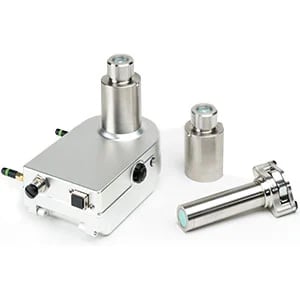The beverage production market is changing
With a growing demand for more varied product recipes, and to respond to the new dietary trends including lactose-free and veganism, beverage manufacturers are having to change how they produce their products - from the processes they use to the powder handling equipment they choose.
Why traditional beverage manufacturers are finding it tough to stay competitive with their existing Industrial Mixing Equipment
The traditional fixed-line manufacturing methodology is perfect for companies producing the same product, day in day out. But with today’s market requirement for varied recipes and batch sizes, manufacturers are having difficulty keeping up with demand and running an efficient operation.
Beverage manufacturers typically produce three to four recipe batches over the course of a week, producing 1,000–3,000 kg product per hour. Many of these recipes are made up of powder ingredients that are formulated and blended to create a homogeneous mixture /product
The common mixing process for powder beverage manufacturers
The mixing process can become one of the pinch points for beverage manufacturers as this stage in the process is where the highest amount of production downtime occurs. Fixed mixers such as ribbon mixers or paddle blenders that can accomplish fast, high-volume blending of ingredients are now not that flexible in meeting today's demands. Recipe changeovers lead to hours of cleaning downtime, during which there is no production.
To perform a full clean that will remove the risks of cross-contamination, the blenders have to be stopped, taken apart (blades removed) and washed. They must then be dried before the next batch can begin to ensure there is no risk to the next batch. This cleaning process often requires a full day with operators focusing on the cleaning regimen. Any shortcuts in the cleaning process can result in cross-contamination from recipe to recipe, as product ingredients can build up in hard-to-access areas.
The risk of transferring materials via pneumatic conveying
Pneumatic conveying systems are also very difficult to clean thoroughly. If the range of final products are all quite similar then it’s not such a problem as common flavors/smells are shared. But with today’s need for more variation of recipes (stronger flavor options and trendy additions), manufacturers are forced to carry out thorough cleaning and surface testing to attempt to control product integrity issues.
Managing powder segregation
In addition, manufacturers also have to deal with ingredient and powder mix segregation issues during transfer and discharge. For example, 3-in-1 beverage manufacturers experience high levels of quality issues because these recipes contain a collection of particles that have different sizes and structures in the mixture. These are commonly prone to blend segregation as the particles move apart during discharge. Manufacturers using butterfly valves or slide valves often experience segregation issues, due the core flow and rolling of powder particles from the container.
Beverage manufacturers identify key benefits to switching to a decoupled and contained IBC system
The Matcon Intermediate Bulk Container (IBC) system enables manufacturers to switch between recipes without the common downtime issues caused by cleaning at the mixer stage as we discussed earlier.
By using an IBC system, you adopt lean manufacturing practices and have the ability to reduce your overall manufacturing costs, increasing the return on your investment. A Matcon IBC system enables varied batch production and quick changeover at the blending stage as the IBC becomes the blending vessel. This method means that manufacturers can be more flexible in production and manufacture to meet demand with small inventory levels and minimal work in progress (WIP).
The advantages of contained processing
Keeping ingredients contained is vital for beverage manufacturers that use 'free-flowing' powders for several reasons. Aside from the high cost of wasted additives and flavorings, airborne powders present health and safety issues for operators and introduce a risk of cross contamination which can negatively affect production.
Butterfly or slide valves are open to the atmosphere during processing and increase the risk of releasing airborne product into the production space. Product can also stick around the valve mechanism and build up, wasting product and again introducing an opportunity for cross contamination.
Ensure mass flow discharge of powders with no particle segregation
Matcon IBCs use Cone Valve technology to discharge powders accurately and effectively. It provides controlled discharge without the risk of segregation or elutriation. There are no entrapment areas within the IBC or Cone Valve itself, and product flows without the risk of the powder bridging, blockages or ratholing.
Near Infra-red Spectroscopy (NIR) improves recipe consistency
Matcon IBC blending can integrate the use of NIR during blending allowing for constant monitoring of the blend and ensuring an accurately mixed recipe. NIR removes the requirement for invasive sampling techniques that is prone to error and the risk of cross contamination (as the container has to be opened).
Mix validation is quick and easy to accomplish with NIR providing real time results while the blender is in motion, and pinpoints the exact moment when the recipe becomes fully homogenized. This data can be used to programme the blender so that it automatically applies the correct mix time.
If manufacturers are curious to test the results of using NIR, contact Matcon’s global testing facilities to book a demonstration of mix validation with NIR using your actual ingredients.

Beverage manufacturers use IBC blending to meet demand and remain competitive
The new market direction has forced beverage manufacturers to identify and adopt new workflows to meet the changing demands of the market, while staying competitive. They have been successful with Matcon IBC Technology including IBC blending and the Cone Valve technology. With the Matcon system they have been able to:
- Facilitate fast and easy recipe changeovers increasing their product portfolio
- Improve their overall product quality and consistency
- Increase production output and reduce cleaning times
- Maximize efficiency by removing bottlenecks at filling and packing stations
If you would like to see how much production time you could save in your facility, download the Matcon powder mixing ROI calculator. Otherwise, contact Matcon for a free consultation where we can help to answer your questions about improving efficiency in your production workflow.
Posted by
Matt Baumber
.webp?width=600&height=100&name=Beverages-Production%20(1).webp)
